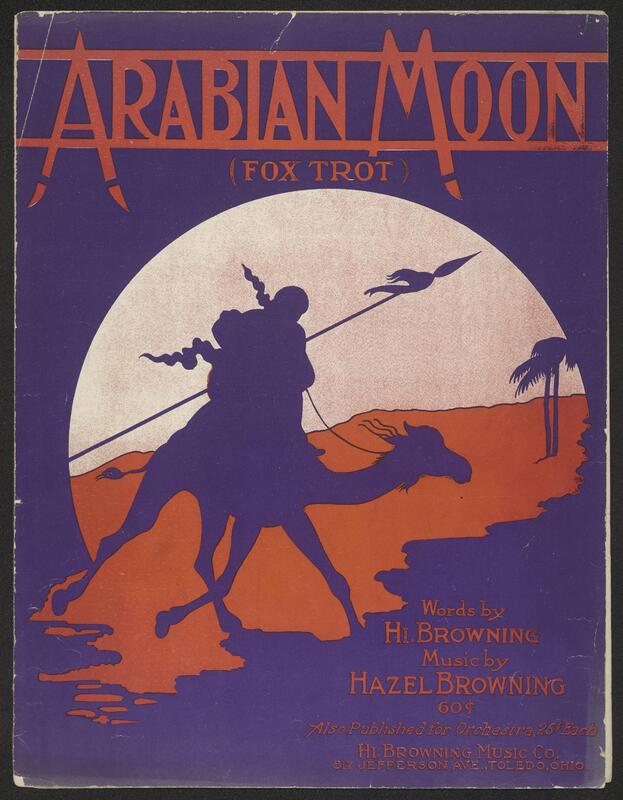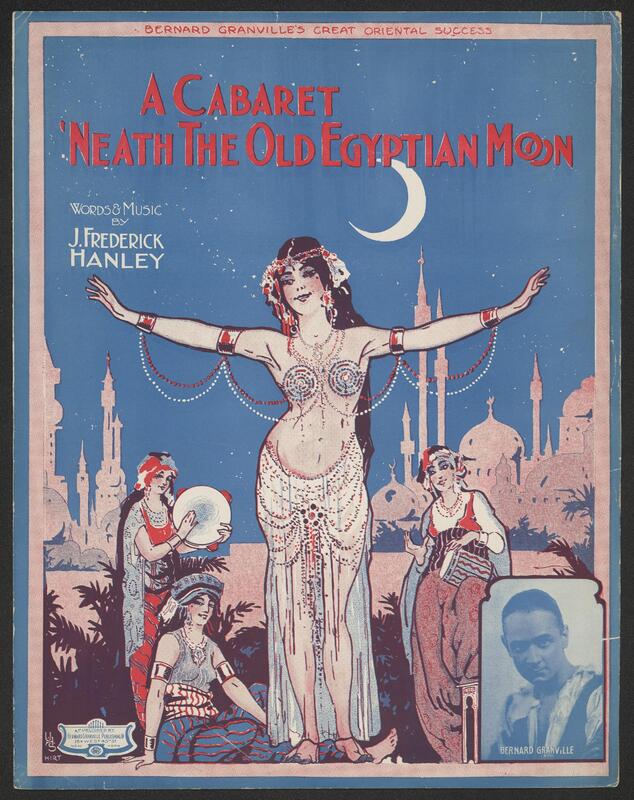Introduction
Hello, and welcome to Across the Burning Sands! My name is Vanessa and I am an undergraduate student at Johns Hopkins University, working with curator Sam Bessen on examining our Special Collection’s collection of Middle East-inspired sheet music. Through this online space, I hope to share a few things that I have worked on over the course of my freshman year as a Freshman Fellow with the Special Collections Archive. I have specifically focused on the variety of ways in which racism manifests in Middle East-inspired sheet music.

Oriental Moon
This cover demonstrates how Egypt, or the Middle East, is often depicted as a mystical, exotic, faraway land, almost dream or trance like. This image also includes a few key symbols that are often included in the album covers, almost as if including these few things is a formula to successfully portray Egypt and the Middle East. Specific items include sand, the moon in the night sky, palm trees, camels being ridden by enrobed people, gold embellishments, and small golden pots or lamps that emit smoke.
Background Information
Before looking through the rest of this exhibit, it is important to understand the historical context and background of the collection. In general, this project can be understood through the term “orientalism”, or the perception of the East by the West. This perception can be influenced by a variety of factors, whether it’s historical events or different technological, societal, or economic inventions. One example of orientalism is Egyptomania, the obsession with ancient Egyptian culture. The main two waves of Egyptomania ignited in response to specific historical events, the first being Napoleon's expedition to Egypt from 1798 to 1801, and the second being the discovery of King Tut’s tomb in 1922. In the 1850s, the tourism industry began rapidly developing, one of the first tourist destinations being Egypt.
However, Egypt was still largely inaccessible to the general public, as it was an expensive and technologically challenging endeavor to visit. As a result, Egypt’s quality of unknownness further fueled the romanticization of Egypt. When people thought of Egypt, they conjured an image of a shimmering Nile River, its banks dotted with lush green palm trees. In the distance through the hot mirages created by the swirling dust of the desert, the distant figure of the Sphinx and pyramids can be spotted. Tales about Egypt spread with clear themes of immortality, eternal love, nostalgia, and exoticism. However, a parallel depiction was that people of Egypt or the Middle East are violent, barbaric, and uncivilized.

Arabian Moon
This simple image illustrates the violence and barbarism that are often implied in album covers and song lyrics pertaining to the Middle East. The person on the camel is seen carrying a spear, and seems to be traveling at a fast pace. Particularly against the red backdrop, a feeling of intensity and violence is evoked.
As I continued looking through the collection, it was clear that Egypt was not the only country of focus. Several illustrated covers and lyrics depict other Middle Eastern countries such as Iran and Turkey, but the collection also includes references to India, Thailand, China, Singapore, and more! This further illuminates the pervasiveness of orientalism, as the West often perceives the East as a large amalgamation of a variety of cultures.

A Cabaret 'Neath the Old Egyptian Moon
This album cover exemplifies the common sexualization and objectification in the portrayals of Middle Eastern women. This is particularly evident through their limited clothing, sheer skirts, and seductive smiles. The background of the cover also provides an example of the architecture that is drawn to imply that the setting is in Egypt or the Middle East. More specifically, the rounded domes and pointed turrets are a common theme throughout depictions.
Now that you have a better sense of the context in which these album covers are being discussed, let’s take a closer look at how racism is expressed in different ways.
Content Warning: The songs in this collection were amassed to document depictions of the Middle East and Asia through sheet music. Therefore, users of the collection will find many songs with explicitly racist, xenophobic, sexist, and other offensive content. While this subject matter is in many cases reprehensible, it is preserved here to honestly and accurately reflect prejudice found in the collection-- even as we recognize that encountering harmful or offensive language can be difficult or painful.